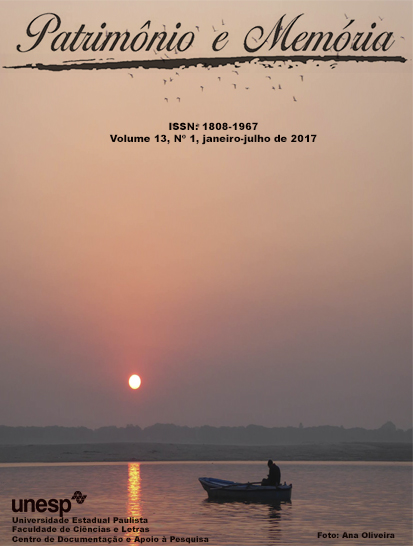Pai Tertuliano, Vó Astrogilda e Pingo, o Guardião
de Memórias Familiares a Patrimônio Cultural no Quilombo de Vargem Grande no Rio de Janeiro (RJ)
Palavras-chave:
Quilombo, Herança familiar, Patrimônio cultural, Materialidade, ImaterialidadeResumo
Em setembro de 2014, a Fundação Cultural Palmares (FCP) entregou a certidão de reconhecimento como comunidade remanescente de quilombolas aos moradores da Serra de Vargem Grande, zona oeste da cidade do Rio de Janeiro. No pedido de reconhecimento, elaborado pela família que lidera o processo, figura como parte importante da sua história a existência de um centro de umbanda espírita, chefiado pela falecida avó Astrogilda. O guia espiritual do terreiro era Pai Tertuliano, um preto velho que se tornou referência em Vargem Grande, muito além do círculo familiar. Os objetos litúrgicos do desativado terreiro permanecem sob custódia familiar, oferecendo um suporte material para suas memórias e desempenhando hoje uma função de autoconsciência familiar e coletiva. Em face do novo horizonte de direitos, interessa entender o trânsito de uma herança familiar para o âmbito da política e da visibilidade, contemplando patrimônio como uma categoria que estabelece mediações entre diversos domínios, social e simbolicamente construídos.
Referências
ARONI, Bruno Oliveira. Por uma etnologia dos artefactos: arte cosmológica, conceitos mitológicos. Revista Proa, n. 2, v. 1, p. 1-27, 2010.
CANANI, Aline. Sapiezinskas Krás Borges. Herança, sacralidade e poder: sobre as diferentes categorias do patrimônio histórico e cultural no Brasil. Horizontes Antropológicos, Porto Alegre, ano 11, n. 23, p. 163-175, jan./jun. 2005.
CAPONE, Stefania. A busca da África no Candomblé: Tradição e poder no Brasil. Rio de Janeiro: Contracapa, 2009.
CARDOSO Vânia Zikàn. Spirits and Stories in the Crossroads. In: BLANES, Ruy; ESPÍRITO SANTO, Diana. (Orgs.) The social life of spirits. The University of Chicago Press: Chicago, 2014. p. 93-107.
CONCONE, Maria Helena Vias Boas. Caboclos e Pretos Velhos da Umbanda. In: PRANDI, Reginaldo. (Org.) Encantaria Brasileira: O livro dos Mestres, Caboclos e Encantados. Rio de Janeiro: Pallas, 2011. p. 281.
GONÇALVES, José Reginaldo. A magia dos objetos, museus, memória e história. In: PRIORI, Ângelo. (Org.). História, memória e patrimônio. Maringá: Eduem, 2009. p. 65-75.
______. Ressonância, materialidade e subjetividade: as culturas como patrimonio. Horizontes Antropológicos, Porto Alegre, v. 11, n. 23, jan.-jun. 2005.
HEIDEGGER, Martin. Construir, Habitar, Pensar. In: Ensaios e Conferências. Tradução Márcia Sá Cavalcante Schuback. Petrópolis: Vozes, 2002.
MAFRA, Clara. A arma da cultura e os universalismos parciais. Mana, v. 17, n. 3, p. 607- 624, 2011.
MAUSS, Marcel. Sociologia e antropologia São Paulo: Cosa Naify, 2003.
MERLEAU PONTY, Maurice. Fenomenologia da Percepção São Paulo: Martins Fontes, 1994.
NORA, Pierre. 1984. Entre mémoire et histoire: la problématique des lieux. In: NORA, Pierre. (Org.). Les lieux de mémoire. Paris: Gallimard, v. 1, La République. XXIV.
ORTIZ, Renato. A morte branca do feiticeiro negro: Umbanda e sociedade brasileira. São Paulo. Brasiliense, 1978.
POLLAK, Michael. Memória, esquecimento, silêncio. In: Estudos Históricos, Rio de Janeiro, v. 2, n. 3, 1989, p. 3-15.
RABELO, Miriam. Construindo mediações nos circuitos religiosos afro-brasileiros. In: STEIL, Carlos Alberto. (Org.). Cultura, Percepção e Ambiente. Diálogos com Tim Ingold. São Paulo: Terceiro Nome, 2012.
CHOAY, Françoise. A alegoria do patrimônio. São Paulo: Estação Liberdade, UNESP: 2006. WAGNER, Roy. A invenção da cultura. São Paulo: Cosac Naify, 2010.
Downloads
Publicado
Como Citar
Edição
Seção
Licença
Copyright (c) 2017 Patrimônio e Memória

Este trabalho está licenciado sob uma licença Creative Commons Attribution 4.0 International License.
Todo o conteúdo do periódico, exceto onde está identificado, está licenciado sob uma Licença Creative Commons do tipo atribuição BY.


